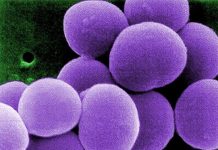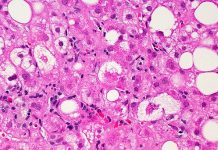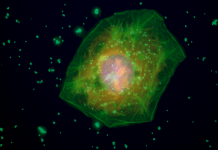The fungus Penicillium roqueforti is used in the production of blue-veined cheese. The exact mechanism behind the unique blue-green colour of the cheese was not well understood. University of Nottingham researchers have unravelled how the classic blue-green veining is formed. They discovered a canonical DHN-melanin biosynthetic pathway in P. roqueforti that gradually formed the blue pigments. By ‘blocking’ the pathway at certain points, the team created a wide range of strains of the fungus with new colours. The new fungal strains could be used to make ‘blue cheese’ with different colours ranging from white to yellow- green to red-brown-pink and light and dark blues.
The fungus Penicillium roqueforti is used worldwide in the production of blue-veined cheese such as Stilton, Roquefort and Gorgonzola. The fungus plays a critical role in flavour and texture development through its enzymatic activity. The characteristic, blue-veined appearance of the cheese is due to pigmentation of spores formed asexually in cavities of the cheese. The unique blue-green colour of the cheese is of great commercial importance.
However, the genetic/molecular basis of spore pigmentation of P. roqueforti is not clearly understood.
Using a combination of bioinformatics and molecular biology techniques, research team of University of Nottingham investigated how the unique blue-green colour of the cheese is formed. Presence and role of DHN-melanin biosynthesis pathway in Aspergillus fumigatus is already described hence the indication of presence of same pathway in P. roqueforti as well. This pathway comprised of six genes whose sequential enzyme activity is known to synthesise DHN-melanin. The research team successfully identified a canonical DHN-melanin biosynthetic pathway in P. roqueforti. The same set of genes were detected and sequenced from the P. roqueforti samples used for experimental work.
The canonical DHN-melanin biosynthetic pathway gradually formed the blue pigments, starting at a white colour, which progressively becomes yellow-green, red-brown-pink, dark brown, light blue, and finally dark blue-green.
The team then used suitable techniques to ‘block’ the pathway at certain points and generated a wide range of strains with new colours.

Further, they investigated the new strains for taste and found that the taste of new strains was very similar to the original blue strains from which they were derived. However, the taste trials revealed that the perception of taste was also influenced by the colour.
The findings of this study can be used in cheese production of different colours and flavours.
***
Reference:
- Cleere, M.M., Novodvorska, M., Geib, E. et al. New colours for old in the blue-cheese fungus Penicillium roqueforti. npj Sci Food 8, 3 (2024). https://doi.org/10.1038/s41538-023-00244-9
***






































